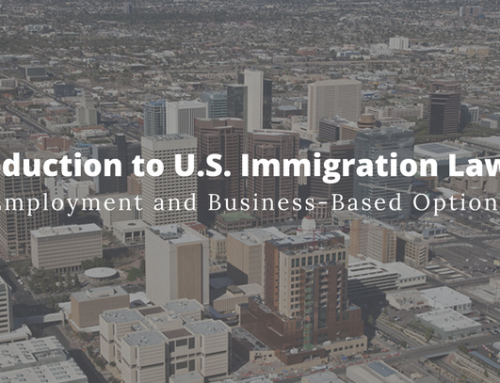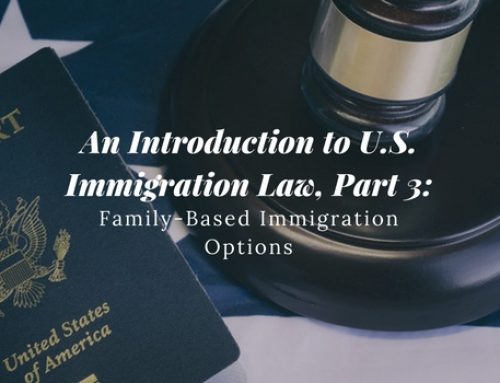An Introduction to U.S. Immigration Law
U.S. Immigration law and policy has been in the news a lot lately. It seems that no matter where you look, you can find someone with an opinion on immigration. Still, there are a lot of people with a lot of questions. The reality is that immigration law is probably one of the most complicated areas of U.S. law. This could be due to the massive collection of federal statutes and regulations that govern the system, or because there are over 5 different federal agencies that play critical roles in the U.S. immigration system.

As immigration attorneys, our goal is to simplify the immigration process as much as possible for our clients. Sometimes we get asked questions that require a deep dive into the complicated web of U.S. immigration law and policy. A lot of questions, however, can be answered in a simple overview of the system. This will be the first post in our series: An Introduction to U.S. Immigration Law. Part 1 below will deal with the difference between a Visa and Immigration Status. Parts 2-5 will follow in the coming weeks and will address the difference between immigrant visas and non-immigrant visas; family-based immigration options; employment and business-based immigration options; and other immigration options.
We know that this series can’t possibly answer every question, but for those who are trying to navigate this system for the first time, we hope it is a helpful starting place.
Part 1: Visa vs. Immigration Status
 First, it is important to understand the distinction between “immigration status” and a “visa.” These two terms are often used interchangeably, but there distinction can be important. For example, a large number of people came to the United States with a visa, but after arriving in the United States changed their immigration status or had their status expire.
First, it is important to understand the distinction between “immigration status” and a “visa.” These two terms are often used interchangeably, but there distinction can be important. For example, a large number of people came to the United States with a visa, but after arriving in the United States changed their immigration status or had their status expire.
Others may have come to the United States without a visa, but have obtained immigration status since their arrival.
What is a Visa?

Some visas allow you to travel to the United States for a single visit, others visas allow a person to travel in and out of the United States on a regular basis. Each time you enter with that visa, the immigration officer at the port of entry determines whether or not your visa gives you permission to be admitted for that particular entry.
What is Immigration Status?
Immigration status refers to the terms of your admission into the United States—it is the set of rights and responsibilities that an individual has toward the U.S. government. Your status usually dictates the amount of time you are permitted to remain in the United States; the types of things you are allowed to do while in the United States; and the types of things you must do in order to remain in the United States. Depending on your legal status, you may be required to have a full-time job, or you may be forbidden from working entirely.

It is also not uncommon for a person’s visa and their status to expire at different times. Sometimes your status will expire before your visa expires—this often* means that you must leave the United States when your status expires, but can seek to re-enter with your unexpired visa. In other cases, your visa may expire before your status expires—this often* means that you can remain in the United States even after your visa is expired, but that if you leave the United States you may need to obtain a new visa before you can seek to enter the U.S. again.
Hypothetical Example: How this Works in Practice
Perhaps the best way to understand the difference between a Visa and Immigration Status is to look at a specific example. The following is a hypothetical case.
Julia is a Mexican citizen who wants to make occasional visits to the United States so she can attend an upcoming family wedding and to make additional trips to visit family and friends. Julia is also an engineer, and although she has a good job in Mexico, she is also interested in interviewing with employers in the U.S. in the future.
After talking to a U.S. immigration attorney, she decided to apply for a B1/B2 visitor visa. She submitted her visa application to the U.S. Consulate in Mexico, along with the supporting documents requested by the Consulate. Once her application was approved, the U.S. consulate
provided her with a visa—a stamp in her passport—that was valid for 5 years.
During the next 5 years, Julia has traveled back and forth to the United States on multiple occasions.
Each time she arrives in the United States, Julia presents her passport which contains her B1/B2 visa. The border official will look at her B1/B2 visitor visa make a determination of whether or not to admit Julia as a visitor. (This typically means that the border official will ask Julia one or more questions about the reason she is coming to the United States). Once the official is satisfied that Julia is qualified to enter as a B1/B2 visitor, he will admit Julia into the United States. Each time Julia is admitted, she is given visitor status for up to 6 months. During that time, she is free to travel within the United States, visit with friends and family, and even to take interviews with potential employers. She is NOT authorized to work while she is in the United States.
If after a job interview, Julia decided to accept an offer of employment, Julia will need to seek a different type of status. She can do this by leaving the United States, applying for another type of visa, and being admitted into the United States under a different status. Alternatively, she may be able to apply from within the United States for a change of status.
*It is worth noting that there are often exceptions to these general rules. Please talk to a qualified immigration lawyer as you make any plans relating to your visa or immigration status.
If you have specific questions or concerns about the differences between a visa and immigration status, or about other aspects of the immigration process, please contact the immigration attorneys at the Gunderson Law Group, P.C. in Mesa, Arizona. We serve clients in Mesa, Phoenix, Tempe, Chandler, Gilbert, Scottsdale, and throughout the state of Arizona and throughout the world.

Arizona Location
1400 E Southern Ave Suite 850
Tempe, AZ 85282
Office: (480) 750-7337
Email: Contact@GundersonLawGroup.com





